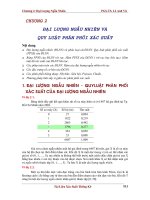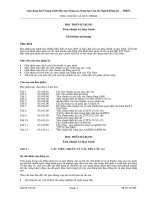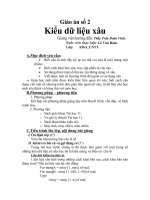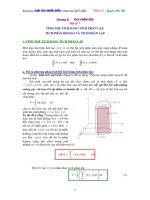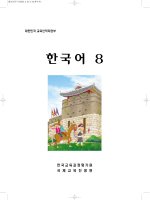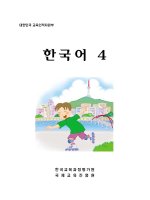Bài giảng korean - life 2
Bạn đang xem bản rút gọn của tài liệu. Xem và tải ngay bản đầy đủ của tài liệu tại đây (4.36 MB, 89 trang )
재외국민용〔영어판〕
한국인의 생활
Ⅱ
지리∙정치 경제∙사회 문화편
kor ˛(¿ ) 2–˙ ( ”æ-‚æ´ ) 2007.1.13 11:20 AM ˘ ` 1 (1,1) Happy n Co - Kcom HP- A3 600DPI 60LPI W
차례
Ⅰ. 한국의 지리
1. 살기 좋은 자연 환경 …………………………………………………………………… 2
⑴ 위치와 영역 ………………………… 2 ⑶ 기 후 ……………………………… 10
⑵ 지 형 ……………………………… 4
2. 산업의 발달 ……………………………………………………………………………… 16
⑴ 농�임�수산업 …………………… 16 ⑶교통, 무역및관광산업 ………23
⑵ 광�공업 …………………………… 20
3. 인구…………………………………………………………………………………… 29
⑴ 늘어나는 인구 …………………… 29 ⑵ 인구의 이동 ……………………… 31
4. 국토 개발과 보전 ……………………………………………………………………… 33
⑴ 국토 종합 개발 …………………… 33 ⑵ 국토의 보전 ……………………… 35
5. 여러 지방의 특색 ……………………………………………………………………… 37
⑴ 중부 지방 ………………………… 37 ⑶ 북부 지방 ………………………… 47
⑵ 남부 지방 ………………………… 41
Ⅱ. 한국의 민주 정치
1. 한국의 민주 정치 ……………………………………………………………………… 52
⑴ 민주주의의 이념 ………………… 52 ⑶ 민주 정치와 국민 생활 ………… 60
⑵ 민주 정치의 발전 ………………… 56
kor ˛(¿ ) 2–˙ ( ”æ-‚æ´ ) 2007.1.13 11:20 AM ˘ ` 3 (1,1) Happy n Co - Kcom HP- A3 600DPI 60LPI W
2. 한국의 정치 생활 양식 ……………………………………………………………… 66
⑴ 헌법의 근본 이념 ………………… 66 ⑶ 국민의 의무 ……………………… 76
⑵ 국민의 기본적 권리……………… 71 ⑷ 정부의 구조와 기능 ……………… 77
Ⅲ. 한국의 경제 발전
1. 경제 개발 계획 ………………………………………………………………………… 86
⑴ 근대화 이전의 한국 경제의 모습 …………………………………………………… 86
⑵ 경제 개발 계획의 추진과 성과 ……………………………………………………… 91
2. 세계로 뻗는 한국 경제 …………………………………………………………… 108
⑴ 한국 경제의 발전 요인 ………… 108 ⑶ 경제 전망 ………………………… 116
⑵ 한국의 국제적 지위 …………… 113
Ⅳ. 한국의 사회와 문화
1. 민족 문화의 발달
……………………………………………………………………… 124
⑴ 민족 문화의 형성 ……………… 125 ⑶ 민족 문화의 창달 ……………… 140
⑵ 민족 문화의 유산 ……………… 128
2. 한국 사회의 변화와 특징………………………………………………………… 142
⑴ 사회 변화의 모습 ……………… 143 ⑵ 앞으로의 과제 …………………… 150
3. 민주 복지 사회의 건설
…………………………………………………………… 152
⑴ 복지 사회의 이상 ……………… 153 ⑶ 앞으로의 과제 …………………… 162
⑵ 한국의 사회 보장 제도 ………… 156
kor ˛(¿ ) 2–˙ ( ”æ-‚æ´ ) 2007.1.13 11:20 AM ˘ ` 5 (1,1) Happy n Co - Kcom HP- A3 600DPI 60LPI W
Ⅰ. 한국의 지리
1 . 살기 좋은 자연 환경
2. 산업의 발달
3. 인구
4. 국토 개발과 보전
5. 여러 지방의 특색
kor ˛(¿ ) 2–˙1(001-050) 2007.1.13 11:20 AM ˘ ` 1 (1,1) Happy n Co - Kcom HP- A3 600DPI 60LPI W
1
. 살기 좋은 자연 환경
( 1 ) 위치와 영역
3343 124
132
위치
—3—
1000 km
3300
22 km
영역
As Korea is situated between the continent and the sea, its location is ideal for
advancing either to the continent or to the sea. Therefore, our ancestors adapted
Chinese culture from the continent to our own culture, and developed a creative and
splendid culture in full blossom, while conveying our advanced culture to Japan.
Korea can take this advantage to advance to the continent and to the sea when
all the people get together as one and bring up the national power.
Territory The territory of a country consists of the territorial land, territorial
sea and territorial air.
The territorial land of the Korean Peninsula is about 1000 kilometers from north
to the south and with more than 3300 large and small islands including Cheju and
Ullung Island, and the total area is about 220 thousand square kilometers, which is
about same size as Great Britain.
1
. THE BEST LIVING ENVIRONMENT
(
1
) Location and Territory
Location Korea is a peninsula which stretches from the north to the south,
located in the 3343 north latitude, and in the 124132 east longitude.
Korea is contiguous to China and Russia across the Amnok and Tuman Rivers to
the north and faces China across the West Sea to the west. Also, she faces Japan
across the East Sea and the Korea Straits in the east and the south.
—2—
한국의 위치
kor ˛(¿ ) 2–˙1(001-050) 2007.1.13 11:20 AM ˘ ` 2 (1,1) Happy n Co - Kcom HP- A3 600DPI 60LPI W
—5—
(2744 m)
(1950 m)
which are high and steep. As we go south and west the contours flatten some-
what. The highest mountain in Korea is Mt. Paekdu(2744 m) in the north, and Mt.
Halla (1950 m) in the south.
The mountain ranges in Korea consists of the Nangnim and T’aebaek Range
which lie from the north to the south and branches radiating to the southwest and
northeast. Vertical ranges like T’aebaek are relatively high and steep, therefore,
cause transportation difficulties and differences in weather forming a border
between the east and the west. The ranges stretching to the west are lower as they
go westward, so we can easily find some basins and plain fields.
(2) 지 형
70
산지
However, unfortunately, our country was divided into the Free South and the
Communist North after liberation. Today, we are building credibility with the north
through conferring, such as in the high-level talks between the south and the north,
to reunify our two countries again.
(
2
) Topography
Mountainous Areas Mountainous areas occupy approximately 70 of the
entire land of Korea. As we go up north and east, many mountainous areas appear
—4—
남북 고위급 회담
한국의 지형
kor ˛(¿ ) 2–˙1(001-050) 2007.1.13 11:20 AM ˘ ` 4 (1,1) Happy n Co - Kcom HP- A3 600DPI 60LPI W
—7—
하천과 평야
There are many mountains which are good sightseeing spots with great views.
Especially, Mt. Ku˘mgang and So˘rak are famous for their beautiful valleys, colorful
autumn leaves and steep peaks of granite.
Rivers and Plains As the Korean topography is high in the north and east and
inclines toward the southwest, major rivers, except the Tuman, Naktong and
So˘mjin Rivers flow southward.
The most salient characteristic of Korean rivers is that there are great seasonal
changes in water levels. It rains heavily in summer, and often, heavy monsoon
rainfall causes the rivers to overflow. In spring, fall, and winter, drought make the
The T’aebaek and Hamkyo˘ng Range are located along the east coast, so their east
slopes are narrow and steep but the west side is wide and plain.
In Korea, where the ground is stabilized, there are no active volcanoes at present,
but there remain places caused by volcanic activities of the past in Mt. Paekdu,
Cheju and Ullu˘ng Island, in some places plateaus formed from molten rocks exist.
Ch’o˘nji in Mt. Paekdu and Paengnoktam in Mt. Halla, by products of volcanic
activities, are great sightseeing resources nowadays.
—6—
백두산 천지
한국의 주요 하천과 평야
kor ˛(¿ ) 2–˙1(001-050) 2007.1.13 11:20 AM ˘ ` 6 (1,1) Happy n Co - Kcom HP- A3 600DPI 60LPI W
—9—
Salt farming and cultivation are well developed in the west coast due to the
extreme range of tides. Recently, Korea covered these mud flats which made more
land available for farming and other industries.
On the south coast, with islands and complex coastlines, the year round warm
weather makes it possible to cultivate laver and oysters. An archipelago was
designated a National Seashore because of its beautiful landscape.
On the east coast, which has no wide plains, we have lakes like Kyo˘ngp’o and
Hwajinp’o, and the clean sands and beautiful landscape make them great sight-
seeing spots. Also, the East Sea forms a good fishing ground with a mixture of cold
해안과 바다
water level of the rivers low. For these reasons, strenuous efforts are being made to
effectively utilize water resources by constructing multipurpose dams on all rivers
to prevent flood and drought, develop power generation, provide consistent water
sources and promote tourism.
There are many basins, which have been good dwelling spots around the high
and midstreams of the rivers, and there are many plains around the low streams.
Kimpo Plain of the Han River, Honam Plain of the Tongjin and Mangyo˘ng Rivers,
Naju Plain of the Yo˘ngsan River and Kimhae Plain of the Naktong River are well
known and used as rice paddies. However plains are rare along the rivers flowing
eastward.
Coasts and the Sea The coastline along the East Sea is generally monotonous,
but the south and west seashores form a ria coast with indented coastlines.
—8—
해안선 비교
동해안의 해수욕장
kor ˛(¿ ) 2–˙1(001-050) 2007.1.13 11:20 AM ˘ ` 8 (1,1) Happy n Co - Kcom HP- A3 600DPI 60LPI W
—11—
5.2
20.8 26
continental climate which shows a big temperature difference between summer and
winter.
The Korean Peninsula, which is vertically long, shows a big difference in tem-
perature between the north and the south, and the topography and currents cause
differences between the west and the east. The average temperatures in January at
Chunggangjin and Cheju are 20.8 and 5.2 respectively, showing a difference
of 26 degrees.
In the case of the east coast, the T’aebaek Range acts as a screen and there is also
the influence of the warm ocean currents. As a result, the east coast areas show a
higher winter temperature than the West Sea areas at the same latitude.
(3) 기 후
계절풍과
대륙성 기후
and warm currents. In the West and the South Sea fishing is well developed due to
the wide continental shelves, and research for oil reserves is on the way. Therefore,
much is expected in further development.
(
3
) Climate
Monsoons and Continental Climate Korea has a unique climate affected by
the air currents occuring between the huge Asian continent and the Pacific Ocean,
even though she belongs to the warm area of the mid latitude.
In summer, due to the North Pacific anticyclone, a hot and humid southwest
monsoon makes the weather hot and rainy. On the contrary, in winter, the cold and
dry northwest monsoon from Siberia makes it dry and cold. So, Korea has a
—10—
겨울철의 평균 기온과 강수량
계절풍과 해류
kor ˛(¿ ) 2–˙1(001-050) 2007.1.13 11:20 AM ˘ ` 10 (1,1) Happy n Co - Kcom HP- A3 600DPI 60LPI W
—13—
〈봄〉
3
〈여름〉
6
6
〈가을〉
1
계절의 변화
In addition the Ullu˘ng Island, the southwest island area and Taegwallyo˘ng,
receive heavy snows.
Changes of the Seasons Korea, located on the globe’s northern mid latitudes,
experiences four distinct seasons with different life patterns.
Spring Spring begins in March, the time that the cold northwestern mon-
soon begins to weaken and warmer and longer days appear. Spring comes up from
the south and farmers begin farming with seedings. One characteristic of spring is
that the weather becomes extremely changeable. It is windy ; yellow sand blow in
from China ; and sudden spring cold snaps are common.
Summer Summer begins in June when the southeastern monsoon blows.
The rainy season begins at the end of June, and excessive rain and typhoons often
cause disaster. After the rainy season, hot summer weather comes.
1100 mm
6, 7, 8
7, 8, 9
여름철에
많은 비
Much Rain in Summer The average precipitation of 1100 mm a year shows
that Korea is one of the rainy areas of the world, but there are large variations in
precipitation among different regions and different seasons.
More than half of the annual precipitation in Korea occurs in summer from June
to August. It is good for rice farming, but sometimes sudden rain causes floods and
typhoons usually occuring in July, August or September damage crops and our life.
The areas where it rains a lot are the Cheju Island, the southern coastline along
the lower stream of the So˘mjin River, along the middle and upper streams of the
Han River, and along the middle stream of the Ch’o˘ngch’o˘n River, and areas where
it rains little are the Kaema Plateau, the lower stream of the Taedong River and the
Taegu basin.
—12—
여름철의 평균 기온과 강수량
kor ˛(¿ ) 2–˙1(001-050) 2007.1.13 11:20 AM ˘ ` 12 (1,1) Happy n Co - Kcom HP- A3 600DPI 60LPI W
—15—
heavy snow causes some traffic difficulties.
The length of each season differs from the north to the south. As we go north we
have longer winters.
〈겨울〉
11
Fall Fall is the best season with its clean and dry weather. Mountains are
colored by autumn leaves, and farmers are busy harvesting crops. The weather,
which gets colder, urges us to prepare for the long winter.
Winter Winter begins in November when the northwestern monsoon begins
to be strong. When the Siberian high pressure system strengthens and the north-
western wind blows, the weather gets cold but when high pressure is weak, we
have warmer days. They call it three days cold and by four warm.Sometimes,
—14—
봄여름 가을 겨울
kor ˛(¿ ) 2–˙1(001-050) 2007.1.13 11:20 AM ˘ ` 14 (1,1) Happy n Co - Kcom HP- A3 600DPI 60LPI W
—17—
population has changed the farming style in Korea. Farmers use more machines,
reducing labor intensive farming, and there are a growing number of people
involved in commercial farming. Because the living standard of the people is rising
and the peoples dietary habits are changing, the consumption of rice is declining,
and instead, the consumption of dairy products, fruits and vegetables is increasing.
To meet this trend, crop farming is diversifying to dairy farming, horticulture and
cash crop farming.
Koreas farming is basically a petty business in a small arable land, thus not
competitive with the large factory farms of the United States or Australia. There-
fore, cheap imported farming products may be good for consumers, but they are
heavily damaging the indiginous rural economy. Today, the problems of trade
deficit and the opening farm products markets are becoming the biggest problems
for our economy.
2
. 산업의 발달
( 1 ) 농∙임∙수 산 업
1
농업
2
.
DEVELOPMENT OF INDUSTRIES
(
1
) Agriculture, Forestry and Fisher y
Agriculture Korea has a small land relative to the population. Because of the
small farming area per capita, we have relied on labor intensive farming.
The main crop is rice because it is more productive in one farming unit than any
other crop or stock farming. The Korean system tends to be self-supplying farming
by which farmers consume most of their products and sell the residue in the market.
But recently, idustrialization, upgraded dietary habits, and a decrease in rural
—16—
경지 정리가 잘 된 논
kor ˛(¿ ) 2–˙1(001-050) 2007.1.13 11:20 AM ˘ ` 16 (1,1) Happy n Co - Kcom HP- A3 600DPI 60LPI W
—19—
수산업
Fishery Korea, which faces the sea on three sides, has a naturally formed
fishing ground with its complex coastlines, mixture of cold and warm currents and
wide continental shelves.
And nowadays, she is progressing to a worldwide fisheries country because of a
increased demand of marine products and the accummulation of capital and tech-
nique.
As the warm current meets the cold current in the East Sea fishing grounds,
various fishes such as pollack, snipe and cuttle fish are caught in winter and summer.
Many different fish are harvested year round in the South Sea area, laver and oyster
cultivation is well developed, and in the ports near the grounds, marine product
processing is well developed. The West Sea also has a wide number and variety of
fishes, but we cannot fish there in winter due to the cold water. The salt industry is
70
625
1960
임업
Forestry Although mountain areas of Korea account for 70 of the entire
land, forest resources are relatively poor.
Forests are distributed mainly along the Amnok and Tuman Rivers in the
northern region, and along the T’aebaek and Sobaek Ranges in the southern region.
The forsets of Korea were once nearly devastated due to indiscriminate tree
felling by the Japanese for war preparations and the Korean War, but the strong
government policies to restore green mountains since the 1960’s along with national
efforts resulted in our forests now becoming thicker.
Even with reforestation, Korea has few forests that are economically valuable.
Therefore, Korea imports most of its forest products.
—18—
울창한 산림
동해 어장에서 잡힌 오징어
kor ˛(¿ ) 2–˙1(001-050) 2007.1.13 11:20 AM ˘ ` 18 (1,1) Happy n Co - Kcom HP- A3 600DPI 60LPI W
—21—
공업
The rapidly industrializing nation of Korea needs more energy resources such as
oil and soft coal and mineral resources like iron ore an copper. Therefore, the rate
of dependence on imports is rising every year.
Manufacturing The manufacturing sector of the Korean economy is based on
processing industries which import raw materials, processes them and exports
finished products. Industrial areas have been developed near harbors which are
best for import and export.
(2) 광∙공업
지하 자원
developed in that area.
Rapid progress has been achieved in deep-sea fishing in the Bering Sea, and in the
Pacific, the Atlantic, the Indian and the Antarctic Oceans.
(
2
) Mining and Manufacturing
Underground Resources Underground resources of Korea are of great variety,
and the peninsula is called a specimen room of minerals, but its reserves are
extremely poor. Most of the resources are buried in the north, and nonmetallic
minerals such as limestone, kaolin and silica are abundant in the south.
—20—
원양 어선
0
20
40
60
80
100
우라늄 철광석 구리 아연 몰리브덴 유연탄
(%)
100
96
95
84
44
100
지하 자원의 수입 의존율 시멘트 공장
kor ˛(¿ ) 2–˙1(001-050) 2007.1.13 11:20 AM ˘ ` 20 (1,1) Happy n Co - Kcom HP- A3 600DPI 60LPI W
—23—
(3) 교통, 무역 및 관광 산업
625
교통
Ch’angwon, Masan, Kwangyang and Yo˘ch’o˘n. It includes a heavy and petrochemi-
cal industries producing oil, steel and iron, ships, automobiles, machinery.
The top priorities for the development of Korean industry are to strengthen
competitiveness by developing value added products, to balance development
between big and small industries, and to unify employers and employees.
(3) Transportation, Trade and Sightseeing Industries
Transportation Road transportation in Korea began to form since the station
employee system of the past and modernized after the Korean War. Today, roads
48
1960
Economically Korea is one of the fast growing countries in the world, and
recently, there have been structural changes from light industry to heavy chemical
ones and to high tech industry which produces higher value added products.
Approximately 48 of the nation’s industry is concentrated in the metropolitan
industrial zones. There also is a synthetic industrial zone around Seoul with easy
transportation, old tradition, big markets, abundant labor and capital. This zone has
been leading national industry since the 1960’s and accomplished A Miracle of the
Han River.
The southeast coastal industrial zone is the second largest one with many fac-
tories. This zone is a coastal area with easy transportation from P’ohang, Pusan,
—22—
남한의 주요 공업 지역
울산의 자동차 공장
kor ˛(¿ ) 2–˙1(001-050) 2007.1.13 11:20 AM ˘ ` 22 (1,1) Happy n Co - Kcom HP- A3 600DPI 60LPI W
—25—
1960 24
Air transportation began to develop in the 1960’s. Due to the 24th Olympics and
northward diplomacy, our airline system was extended across the whole world.
Kimp’o Airport in Seoul, Kimhae Airport and Cheju Airport are international
airports which are connected with most of the countries in the world.
Domestic flight take people to the major cities of the country such as Pusan,
Taegu, Kwangju, Yo˘su, Chinju, Sokch’o, Cheju, Ulsan, Yech’o˘n.
1
1899
connect every place in Seoul like a web, so we easily can go anywhere in the country
by car.
The construction of freeways and industrial roads, and the increasing number of
automobiles make it possible for us to travel any place in the country in a day.
Railroad transportation opened with the Seoul-Inch’on line in 1899, with the
construction of trunk railroads such as the Seoul-Pusan, Seoul-Shinu˘iju and Seoul-
Wonsan lines following.
After liberation, industrial railroads were built and main lines were doubled and
electrified. Subway systems are running in the Pusan and Seoul metropolitan areas.
—24—
고속 도로
서울의 지하철 항공 교통(KAL)
kor ˛(¿ ) 2–˙1(001-050) 2007.1.13 11:20 AM ˘ ` 24 (1,1) Happy n Co - Kcom HP- A3 600DPI 60LPI W
—27—
관광
Sightseeing As people have better incomes and more leisure time, the growing
number of tourists ard developing the sightseeing business. This business contrib-
utes to international friendship, national prestige and acquisition of foreign cur-
rency and is called invisible tradeor a factory without chimneys. Korea has
many sightseeing resources such as beautiful landscape, traditional customs and
cultural heritage artifacts. Industrialization and urbanization diversify our
resources.
Therefore, there are increasing numbers of domestic and foreign tourists since
1964
1990 650
1980
1990
무역
Trade The trade of Korea has recently developed remarkably in scale due to
our economic development. Exports have rapidly increased since 1964 and went
over 65 billion US dollars in 1990.
Until the end of 1980’s our accounts were in the black, but since 1990’s it has been
hard to keep a balance in trade.
Major export goods are industrial products such as electronics, fabrics, iron,
automobiles and ships, and import goods are raw materials such as oil, lumber,
crude rubber and wool. The United States and Japan are our major trade partners
and we also trade with many other countries of the world like China, Russia, etc.
—26—
무역선
경복궁을 관람하는 관광객
kor ˛(¿ ) 2–˙1(001-050) 2007.1.13 11:20 AM ˘ ` 26 (1,1) Happy n Co - Kcom HP- A3 600DPI 60LPI W
—29—
3
. 인 구
( 1 ) 늘어나는 인구
1945 2600
1600
1949 2000 19501953
625
(baby boom)
1960
1990
인구 증가
3
. POPULATION
(
1
) Increasing Population
Increase in Population At the time of liberation in 1945, the population of
South and North Korea was about 26 million. The population of South Korea was
about 16 million, but many Koreans living in Japan and China returned home and
many North Koreans also came to South Korea, and by 1949, the population of
South Korea was over 20 million. The time period of the Korean War(19501953)
brought about a great increase in Korean population. Although many lives were
sacrificed during the war, many people came down from the north.
As soon as the war came to an end, a baby boom occurred and the Korean
250
5
the Seoul Olympics that reach to 2.5 million people every year. The government has
designated national parks, provincial parks, and proceeds in a synthetic develop-
ment plan dividing the country into 5 major travelling sections.
—28—
설악산 국립 공원
kor ˛(¿ ) 2–˙1(001-050) 2007.1.13 11:21 AM ˘ ` 28 (1,1) Happy n Co - Kcom HP- A3 600DPI 60LPI W
—31—
(2) 인구의 이동
국내 이동
In the rural areas, the proportion of older people is increasing and this demonstrates
a labor shortage in the farming regions.
(
2
) Migration
Internal Migration There were migrations from the north to the south during
the Korean War, and in the process of modernization, people tended to move
toward the industrializing areas and their satellite cities. Today, there are still
growing numbers of people who leave rural areas for urban areas due to industrial-
ization and urbanization.
0.97 19904300
6500
1960
인구 분포
population grew rapidly. However, since the end of the 1960’s, due to family
planning and higher education, the birth rate has dropped to 0.97 in 1990. The
population as of 1990 is approximately 43 million in the south and 22 million in the
north.
Population Distribution Population distribution in Korea is affected by its
topography and the distribution of farm land. A large number of people live in the
southwestern area and a small number of people in the northeastern area. But we
have a huge population in big cities due to urbanization and industrialization since
the 1960’s. Simultaneously, the population of rural areas has decreased.
Large urban areas now face many difficult problems in regard to housing, tran-
sportation, water supply, sewage systems, garbage disposal, pollution and urban
crime. Rural areas, on the other hand, face obstacles to production due to the
shortage of workers caused by the exodus of the younger generation to urban areas.
—30—
인구 분포도
수도권 대도시 지역의 인구 증가율 복잡한 서울 도심
kor ˛(¿ ) 2–˙1(001-050) 2007.1.13 11:21 AM ˘ ` 30 (1,1) Happy n Co - Kcom HP- A3 600DPI 60LPI W
—33—
4
. 국토 개발과 보전
( 1 ) 국토 종합 개발
1972
10
19912
1992 3
5
3
4
. DEVELOPMENT AND PRESERVATION OF
THE NATIONAL LAND
(
1
) Synthetic Development of the Land
To use and develop the land effectively, Korea has been planning and propelling a
10 year synthetic land development plan since 1972. As the 2nd development plan
segment became complete at the end of 1991, we are propelling the 3rd development
plan.
Due to the synthetic land development plan and 5 year economic and social
development plans, industries were further developed and the national life style has
materially improved. On the other hand, excessive concentratioon of industrial
facilities and population has centered in big city areas such as Seoul, Pusan, Taegu
70
1970
120 200
(CIS)
500
국외 이동
External Migration Korean people moved to Kando, China, Japan and Russia
before independence from Japan, and there also were people who migrated to
Hawaii. Most of the migration to Japan was by forcible draft, so there are now
approx, 700 thousand Koreans living in Japan.
After independene, external migration was strong from the 1970’s. Today, 5
million Koreans including 1.2 million in the U.S.A. and 2 million in China live abroad
in places like CIS, South America and Europe.
Recently, as people go overseas to work, many Koreans are also living in south-
west and southeast Asia and in Africa.
—32—
kor ˛(¿ ) 2–˙1(001-050) 2007.1.13 11:21 AM ˘ ` 32 (1,1) Happy n Co - Kcom HP- A3 600DPI 60LPI W
—35—
6
(2) 국토의 보전
1960
developing and conserving resources, developing the land suitable to its need
extensively and supplying housing, developing the area that the South and North
will exchange in preparing for reunification.
(
2
) Preservation of the National Land
Our environment is being destroyed by disposed waste materials from carelessly
planned development, various industries and the people’s domestic refuse rather
than by various natural disasters. It is very difficult to restore the environment once
it is damaged. For this reason, preservation of the environment is very important.
Recently, contamination of the environment in the wake of urbanization and
industrialization is our most serious problem.
Contamination of the environment began to emerge as a social problem as people
3
and Inch’o˘n. The 3rd 10 year synthetic land development plan includes a counter-
plan to solve the associated problems.
The 3rd plan presents development focussed basically on rural area, land
utilization to inrease production and save resources enhancing national welfare and
preservation of the environment, and forming a national base preparing for
reunification.
To reach these goals, we are propelling plans in 6 areas : developing rural
area and restraining the concentration on city areas, fostering hightech industry
by constructing new industrial areas, constructing and expanding communi-
cations networks and high speed transportation for rapid circulation of materials
and informationing, preserving on amenable national life environment and
—34—
통신망의 확대
kor ˛(¿ ) 2–˙1(001-050) 2007.1.13 11:21 AM ˘ ` 34 (1,1) Happy n Co - Kcom HP- A3 600DPI 60LPI W
—37—
5
. 여러 지방의 특색
( 1 ) 중부 지방
600
1988
수도권
5
. VARIOUS REGIONAL CHARACTERISTICS
(
1
) The Central Region
The central region has been the center of politics, economy, culture and trans-
portation for a long time because it is located in the middle of the peninsula.
Capital Region The capital region is the one which includes Seoul, its suburbs
and Inch’o˘n and its surroundings, and from the early days, the Korean history has
centered around this capital region. Seoul developed as the center of national life
for more than 600 years since it became the capital of the Choso˘n Dynasty.
Especially, since the Seoul Olympic Games in 1988, Seoul has become one of the
biggest international cities.
(green
belt)(blue belt)
became concentrated in cities and the heavy and chemical industries developed
rapidly. This has gone on since the latter half of the 1960s. The most seriously
contaminated sectors are the air and water.
Today, Korea, to preserve a brighter and more beautiful land, prescribes environ-
mental rights in the consititution, makes laws against environmental pollution, has
established the Ministry of Environment, and endeavors to prevent pollution in
dividing the country into several environmental areas.
We are achieving successful results by establishing purifying facilities such as
green belt, blue belts sewage disposal plants and trash furnacing facilities.
—36—
서울의 서부 위생 처리장
kor ˛(¿ ) 2–˙1(001-050) 2007.1.13 11:21 AM ˘ ` 36 (1,1) Happy n Co - Kcom HP- A3 600DPI 60LPI W
—39—
food grains. The T’aean Peninsula, where sea bathing thrives in Taech’on, Mallip’o
and Yo˘np’o, is national seashore where many travellers visit during the summer.
Taejo˘n has been greatly developed as an important transportation city, and as the
biggest city in this region and a center of administration. The national park
Kyeryong Mountain and Taech’o˘ng Lake will be developed as major resorts.
Ko˘ngju and Puyo˘ preserve many relics as the capital of the ancient kingdom of
Paekje. Ch’o˘ngju is the capital city of the North Ch’ungch’o˘ng Province and is also
an educational center. The multipurpose Ch’ungju Dam plays a great role together
with the national park Songni mountain in developing tourist resources in this area.
40km
호서 지방
Inch’o˘n, Puch’o˘n, Kwangmyo˘ng, Anyang, Kwach’o˘n, Suwon, So˘ngnam, U
˘
ijo˘ngbu
and Ansan are satellite cities located within 40 kilometers of the center of Seoul,
and they partially share the functions of Seoul by having a close relationship with
it.
Dairy and horticultural farming has developed in neighboring rural districts of
the National Capital region, turning out milk, vegetables, flowers and fruits in
abundance.
Hoso˘ Region Hoso˘ region is divided into the South and North Ch’ungch’ong
Provinces with the Ch’aryo˘ng Range as demarcation line. The coastline of the
West Sea is very complicated. Recently, in the Asan Bay, Sapkyo River and
Ch’o˘nsu Bay, construction of tide embankments and land reclamation projects were
formed to secure sources of agricultural water and to increase the production of
—38—
중부 지방
충주 다목적 댐 법 주 사
kor ˛(¿ ) 2–˙1(001-050) 2007.1.13 11:21 AM ˘ ` 38 (1,1) Happy n Co - Kcom HP- A3 600DPI 60LPI W
—41—
70
(2) 남부 지방
Many tourists from all parts of the country visit the So˘rak mountain national
park. Scenic places such as the Naksan Temple and Kyo˘ngp’odae and other beaches
attract people to this region. Kangnu˘ng is in the center of this region and plays an
important role as a tourist resort. An increasing number of people have visit Mt.
So˘rak and the east coast as transportation has developed.
The T’aebaek Range area of the southern Kangwon Province is the largest
mining district in South Korea. Its rich underground resources, including coal,
limestone, and tungsten have been developed. More than 70 of South Korean
anthracite is mined in Samch’o˘k, Yo˘ngwol, Cho˘ngso˘n and T’aeback while Sang-
dong is a world renowned tungsten producing site.
관동 지방
Kwandong Region The Kwandong region is divided into the Yo˘ngdong area
and the Yo˘ngso˘ with the T’aebaek rangs as demarcation line. Located to the west
of the mountain Range, the Yo˘ngso˘ area lacks broad plains but has well-developed
mountainous basins at Ch’unch’o˘n and Wonju. These basins have been the basis of
life since early times. Stock raising thrives as this area is studded with relatively
broad mountain slopes. Large pastures have been developed in the high regions,
such as at Taekwallyo˘ng, and high ground agriculture thrives because of the cool
weather.
Yo˘ngdong area is the narrow strip of land east of the T’aebaek Range. It is
connected with the Yo˘ngso˘ area by many ridges such as the Taekwallyo˘ng and
Chinburyo˘ng.
—40—
방목을 위한 대관령의 초지 조성
kor ˛(¿ ) 2–˙1(001-050) 2007.1.13 11:21 AM ˘ ` 40 (1,1) Happy n Co - Kcom HP- A3 600DPI 60LPI W
—43—
1960
2
Garden crops such as vegetables and flowers are supplied not only to Pusan and
Taegu but far away to Seoul. Sangju, the upper reaches of the Naktong River, form
the nation’s largest sericulture base. Taegu, Yo˘ngch’o˘n and their surrounding areas
are well known for apple production.
Also, this region has made rapid development from the early 1960’s centered
around Pusan, Taegu, Masan, the traditional industrial regions. It has formed the
southeast coastal industrial zone centered around P’ohang, Ulsan and Ch’angwon
and became the nation’s largest heavy chemical industrial zone.
Pusan is the second largest city and the biggest trade port in Korea.
Kyo˘ngju, which has long been the administrative and cultural center of the
Yo˘ngnam region and was the capital of ancient Shilla, is developing into an
international tourist resort. It is well known for the Pulguk Temple and So˘kkuram
grotto temple.
80
영남 지방
(
2
) The Southern Region
The southern region contains the South and North Cholla Provinces, the South
and North Kyo˘ngsang Provinces, Cheju Province. The region blessed with a warm
climate and broad plains and basins is the largest granary in the country. Fishing
and marine industries are also highly developed.
The southern region is divided into the Yongnam region and the Honam region
with the Sobaek Range as dividing line.
Yo˘ngnam Region Rice farming thrives in the Yo˘ngnam region except in
mountainous areas along the upper stream of the Naktong River. As this district is
relatively warm in winter, barley is grown as a double crop. This district accounts
for more than 80 of the nations total barley output. Horticulture thrives in addi-
tion to rice farming in the Kimhae Plain at the estuary of the Naktong River.
—42—
영남 지방
경주 보문 단지
kor ˛(¿ ) 2–˙1(001-050) 2007.1.13 11:21 AM ˘ ` 42 (1,1) Happy n Co - Kcom HP- A3 600DPI 60LPI W

